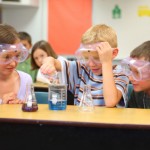
Bonus Marine Biology Projects!
Thanks so much for joining me for the teleclass! On this page you'll find the videos for the experiments we covered in class, plus a few extras. Enjoy!
 Click Here to enroll in e-Science for the 2018-19 school year AND get all the free bonuses. Start using it today!
Click Here to enroll in e-Science for the 2018-19 school year AND get all the free bonuses. Start using it today!
Enroll in the e-Science curriculum starting today, and going until September of 2017. Includes summer e-Camp, complete Civil Engineering course and LOTS more! Full money-back guarantee. Click here to check it out.
Laser Microscope
Did you know that you can use a laser to see tiny paramecia in pond water? We're going to build a simple laser microscope that will shine through a single drop of water and project shadows on a wall or ceiling for us to study.
Materials:
- red or green laser (watch video for laser tips)
- large paperclip
- rubber band
- pond water sample (or make your own from a cup of water with dead grass that's been sitting for a week on the windowsill)
Gummy Bears and Lasers
It’s really hard to understand that when you see a red apple, what’s really happening is that most of the wavelengths that make up white light (the rainbow, remember?) are absorbed by the apple, and only the red one is reflected. That’s why the apple is red.
Materials:
- red laser (cheap laser pointers from the dollar store work great)
- red and green gummy bears
- flash light
Salty Eggs
Saltwater is more dense that regular water, and your body tissues contain water (among other things). Did you know that thinner people are more dense than heavier people? For example, championship swimmers will sink and have to work harder to stay afloat, but the couch potato next door will float more easily in the water.
Materials:
- glass
- water
- salt
- hard boiled egg
Ocean Chemistry
pH is a scale from 1 to 14 that measures how acidic or basic something is. Lemon juice is a 2 so it’s an acid. Water is neutral at 7, and something like baking soda is basic because it’s 10.5. The pH of the ocean is about 8. Scientists are worried, though, because the ocean used to be 8.2.
Materials:
- lemon juice
- distilled white vinegar
- baking soda
- water
- red cabbage
- blender
- strainer
Waterbots
We're going to use foam to create a waterbot, which will be powered by a simple electrical circuit. The hardest part of this activity will actually be building it stable enough so it doesn't capsize. Boats are always built in a way so they don't get pushed or flipped over easily by carrying a ballast, or extra weight, at the lowest part of the boat. You'll need to figure out where to out your motor and batteries (which weigh a lot compared to a foam block) in order to balance your boat. Materials:
- 1 propeller
- foam block (this can be a scrap piece from packing material)
- 3V DC motor
- AA battery case with AA batteries
- 2 alligator clip lead wires
- hot glue gun with glue sticks